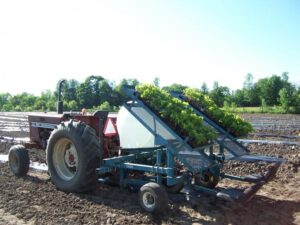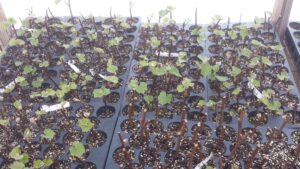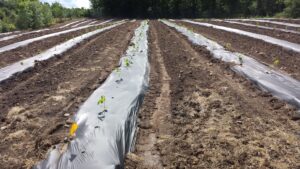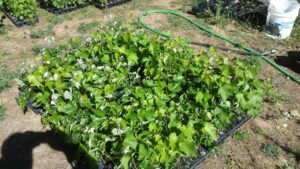2016 Annual Report for FNE16-849
Propagating grapevines in cell plug trays and using a water-wheel transplanter in establishing a vineyard
Summary
This project aimed to develop/evaluate a more efficient and economical way to propagate and transplant grape vines. Vines are normally planted using bare root or large potted vines either by hand which is very labor intensive or with a transplanter (some are laser guided) which can also be very expensive. This project is evaluating a method of propagating vines from smaller cuttings into cell plug trays and planted with a much less expensive water wheel transplanter. This method was evaluated in a replicated experiment comparing it to a current standard method of vineyard establishment using hand planting. Outreach so far took place through two field workshops during the season and later will include a booklet available as either a printed or electronic version detailing the process and the results of this. This project has the potential for a sizable economic impact as vineyards are being established at increasing rates. I have attempted to quantify this impact by establishing cost savings using this method. There are hundreds of vineyards which could implement this method. It could also lead to new or existing nursery businesses growing vines in cell plug trays and possibly some new mobile planting services using this type planter.

The Technical Advisor for this project is Anna Wallace who is the CCE Cooperative Extension Associate Fruit Specialist for the Eastern NY Commercial Horticulture Program. She worked with me to insure I included the proper methods to use for preventing the spread of diseases and viruses when propagating vines and also getting the proper authorization to propagate patented and protected varieties. She also participated with the second field meeting where we planted the vines in the vineyard.
Jay White is also a cooperating farmer with this project. I worked closely with him in the collection process, methods of callusing the cuttings, sticking those cuttings into plugs and growing those plugs ready to set in his vineyard. Jay also helped plant the plugs at my vineyard in the second field meeting. He also soon afterwards used the planter to set about 4000 vines he propagated using this method in his own vineyard. He made a video of this which I will be sharing in the final report.
Objectives/Performance Targets
The project centered on rooting and growing hardwood cuttings of hybrid grape vines in cell type plug trays to be later planted in a vineyard using a common water wheel vegetable transplanter. The cost to grow these vines will later be compared to the cost of the same variety of vines purchased from a nursery. ** One point I emphasized during this project during outreach sessions, is that many grape vine varieties are protected by patents and royalty programs. The developers and breeders of these varieties have a lot invested into them and deserve to receive their payments. I have obtained all necessary permissions to propagate the vines. All outreach participants will be expected to do the same.**
The first objective of the project was to use plug trays with smaller 2 bud cuttings (as opposed to traditional 4 to 5 bud cuttings) to propagate more economical grape vines. The process of planting 2 bud cuttings and growing into healthy vines is relatively easy with basic guidance. Propagation work began with collection of bud wood to be used for cuttings in early March. The buds need to be good viable buds not injured through winter cold, etc. Normally a live bud count is helpful in selecting the proper wood for cuttings. I will cover this in the final report but this year was not an issue because of the warm winter we had. The bud wood desired should have internode spacing of two to four inches and no more if possible.
The shoots were selected and rough cut to manageable lengths for handing and tied into bundles and brought back to storage for processing the cuttings. The cuttings were selected from the most desirable buds in pairs of two. The proper cuts were made to ensure the cuttings will be planted the right side up as they will not grow planted upside down. The lower cut was made slightly below the bud node and was cut flat. The flat angle denotes the base. The cut above the second bud was about three quarters inch above the second bud on a 45 degree angle. The cuttings were then callused which is necessary for root formation. This took place on a heat mat which was temperature controlled.
Once callused the cuttings were placed into 38 cell plug trays filled with a good rooting and growing medium. The heat from the sun hitting the black or dark gray plastic trays helps to promote root formation sooner. To monitor this heating I used a soil temperature data logger. This allowed for constant monitoring of the soil temperature. The vines were then moved to and grown in the greenhouse until ready to harden off for a week before setting out into the vineyard (target date June 26 this year). All of the chores needed to grow the vines were be logged for time and notes kept of the activity performed. Costs can be assigned to the growing of the vine for comparison to a purchased price. Costs of the purchased vines will not reflect the royalties paid as the vines grown will pay the same royalty to the grower.

The second objective was to use a water-wheel for transplanting the vines in the vineyard. A basic water- wheel type planter can cost around $2000 or may be rented in some areas inexpensively as they are common in many vegetable growing areas. Land preparation was the same for both types of plantings since they are in the same vineyard. In late May the new vineyard was sprayed to kill all the grass and perennial weeds growing there since it was an old hay field previously. Two weeks later the field was plowed with a moldboard plow, allowed to dry for a few days and then disc harrowed smooth. Once prepared for planting the rows were laid out using marking flags with a ten foot spacing. I laid a black plastic mulch over the rows using a raised bed mulch layer. This keeps down weed competition for the young vines which is necessary for quick establishment. 2016 was a dry spring, summer and fall at the location so the mulch also helped conserve water since we did not irrigate for this trial.
At the second outreach workshop June 26 the vines being planted with the water wheel were transported to the vineyard at planting time and loaded on the planter. Normally there is one driver and two people riding on the planter placing vines in the planter holes which were approximately six feet apart. The planter uses water which it applies into the punched hole during planting. We quickly discovered that the soil was so dry that the holes did not form well. As a result one helper rode the planter feeding the vines into the appropriate hole and the second person went behind and pushed the vine into the hole for better contact with the applied water. I have never had to do that before and I am sure it was because of the dryness of the soil at time of planting. This slowed down the process a bit but we were still able to plant each row of 50 vines in six minutes.
The temperature that day was in the low 90’s and with the dry conditions we opted to wait to plant the bare root vines until a later date when it was a bit cooler. June 28th the vineyard received over an inch of rainfall and the temperatures dropped some so on July 4th the bare root vines were planted. The bare root vines were hand planted with the roots spread out into holes dug with a shovel and the hole back filled. Again all operations have their time recorded to give a labor value to the operation. Later this project will compare expenses required for growing and planting the vines grown in plug trays and planted with the water wheel transplanter versus purchased bare root vines planted by hand.
The planting itself is made up of three rows of 50 vines planted with the transplanter and then a row of 50 bare root hand planted vines. This will be replicated two times for a total of eight rows. All vines are approximately 6 feet apart. We also logged progress of the vines as they grew during their first year of development in the vineyard. The measurements were taken and recorded about once a month and pictures taken. Information was gathered on vine survival rate and overall growth the first year. This will help quantify any major growth differences between the two planting methods. Later the project will cover a cost comparison between using the cell plugs/planter and hand planting of purchased bare root vines.

Accomplishments/Milestones
The project proceeded fairly smoothly this year in spite of a few challenges encountered through the seasons. The early project proceeded along with plans and anticipated outcomes. Winter had been fairly mild so obtaining the proper bud wood from the vineyard was easy as there was little bud damage due to extreme cold. The cuttings were made using the two varieties selected for the trial, namely a red, Sabrevois (vigorous) and a white, Petite Ami (less vigorous). The Sabrevois callused easily and pretty quickly giving a nice long period for rooting and growing the vine cuttings out into nice small vines around 12 to 15 inches at planting in a total period of about 2 months. The Petite Ami proved to be a bit more difficult to form calluses taking an extra 2 to 3 weeks. As a result and because of lower vigor of the variety, the vines were smaller at planting – around 9 to 12 inches.

As stated above the spring and early summer were very dry making it more difficult to get a nice bed for planting the vines in. The mulch layer had a more difficult time pulling in and shaping a nice solidly formed bed to lay the mulch over. When the planter punched holes for planting the soil tried to fill back in before the water released into it could soak in good. In spite of the difficulties encountered with this, the vines planted with the planter took off growing and never wilted appreciably after planting. The bare root vines were held an extra week for planting until after we received a one inch rainfall. More help was enlisted for that planting and they began growing soon after.
Jay White of Boquet Valley Vineyard acted as a collaborating farmer in this project and grew approximately 4000 vines using this basic system. I had him come to Hid-In-Pines Vineyard and help me or have me show him how to do the various stages of the system. He would then take that information and skill home to implement at his vineyard. In general he got a pretty good rate of rooting and growth. Some rodent got into his small greenhouse and tipped a lot of the cuttings over led to some extra work. He made sure to close the door in the evening after that. He incorporated most steps of the project but did make a change that I would not recommend. He did not use the plastic mulch over the bed and instead planted in bare soil. Before he planted they received a heavy rain and his soil has some clay in it. Because the wheel did not have the dry mulch to roll over, it would bunch up with soil during planting and would require stopping periodically to clear the sticky soil balls. They were able to plant those 4000 vines over a few days and did save a significant amount of planting time.
As summer proceeded it continued dry overall and limited the growth of the new plantings. The vine growth was monitored visually and pictures were taken but no direct measurements were taken of individual vines. I felt that such measurements would be unrepresentative of normal growth in a normal year since the growing season was atypical with a moderate to severe drought underway. Instead I took pictures of the growth for visual comparison and noted general vine health and vigor. The planting was monitored for disease and insects. Since it was dry in general they received no fungicidal spray. Early in August the Japanese beetles got to a damaging thresh hold so an insecticidal spray of Sevin was applied. That kept them in acceptable levels for the rest of the growing season.
Overall both sets of vines grew fairly well in spite of the dry weather conditions. Survival was very good with only a few vines needing replacement next year in either the bare root vines or the ones planted from the plugs. In general the vines at Hid-In-Pines Vineyard are mostly in the two to three foot range for growth for both sets although the Sabrevois are a bit larger. The spring after the initial planting year typically has the vines cut back to about 2 to 3 buds before bud break. This concentrates the stored energy in the roots to make a stronger larger shoot which will later become the trunk. Because of this any size advantage of the bare root (if any exists) is lost. This initial cutback makes for a healthier more uniform vineyard. I look forward to summarizing the results and methods into a final report and ultimately a planting guide of sorts.
Collaborators:
CCE Extension Associate - Fruit Specialist Eastern NY Commercial Horticulture Program
Cornell Cooperative Extension-Clinton County
6064 State Route 22 Suite 5
Plattsburgh, NY 12901
US
Office Phone: 518.410.6823
Boquet Valley Vineyard
2403 Route 22
Essex, NY 12936